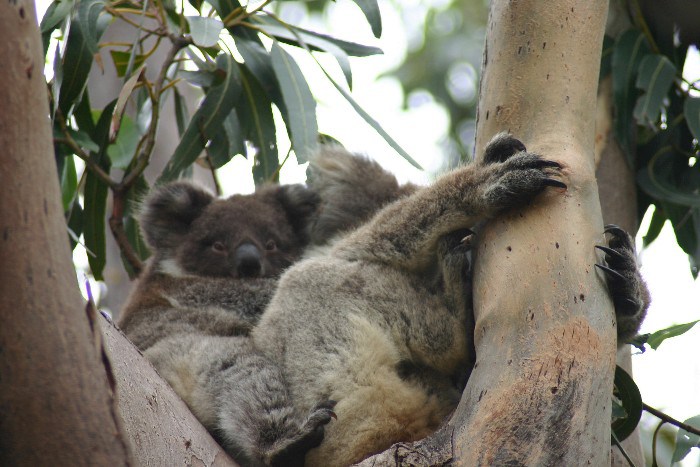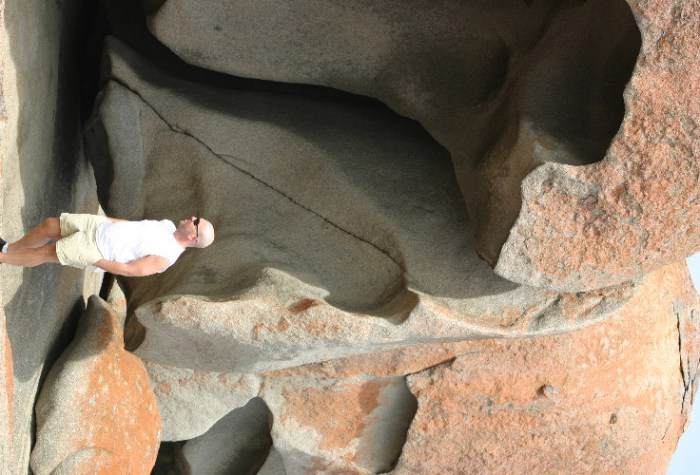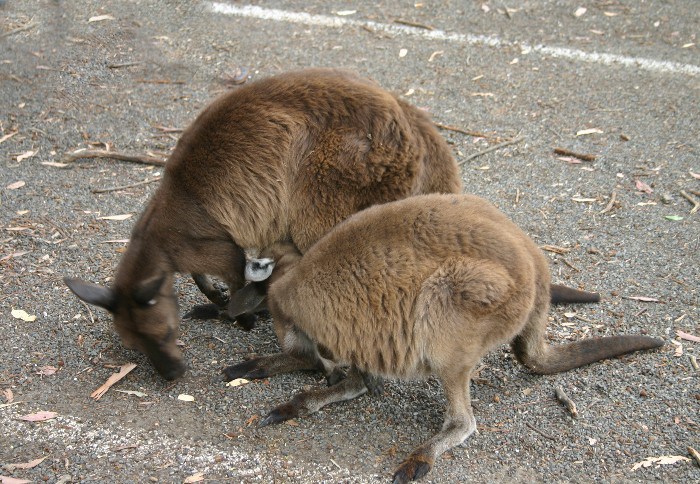This is one of those days that Greg has been dreading.
Up at 5:30!!!!! On the bus at 6:30 for the 2-hour ride to the ferry (45 minutes) that takes us across to Kangaroo Island, where there is a huge wildlife sanctuary, Flinders Chase National Park. This is a full day of travelling and we choose again to do the Gray Line thing. There are many options for travelling to KI, flying, driving or by bus and we choose the option that fits our timing and our budget. Some confusion ensues at the Bus Station concerning which bus everyone should be on. We hear a rumour that there are three buses going to the ferry and we won’t be on the same bus for the tour. We need a specific ticket to get us on the bus and then a special pass to get us on the ferry and then we need to check in again on the other side to determine which tour we are on…..and don’t forget it is 6:15 am!
KI is about 155 kilometres long, and about 55 kilometres wide. While some of it has been farmed for many years, about half of the island has never been cleared, and it is, therefore, an ecologically important area, with native bush predominating. Very few non-native animals have been introduced, with the result that the local animals have not become food for the interlopers.
Seeing Sea Lions!
The first stop on Kangaroo Island is an Australian Sea Lion colony. Our driver, Dave, is full of all kinds of historical information, some helpful and interesting, some not so. I am not sure how interesting some of this information is to our fellow travelers – mainly Japanese, Korean and German. We walk onto the beach where the sea lions are sleeping – we are so close to them, just 5 metres away from us. The adults go out into the water for 3 days at a time, travelling hundreds of kilometres to their feeding ground. The waters are full of predators, so they don’t sleep for the 3 days, and when they get back to shore, they often use the waves to push them on-land because they are so tired. That is how we are able to go so close without disturbing them – they are oblivious to everything except the sun, raising their flippers or rolling in the wet sand to cool down, going up into the grasses on the dunes to warm up in winter. This colony is one of the very few that have survived the oil and fur trade, mainly because the beach is protected by a reef just offshore that meant the sealers couldn’t get into the beach. The reef not only helped the sea lions survive humans but also their finned predators because the predators won’t come into the lagoon. However, it also means that the water here is warm, and so the good feeding grounds are far away. (Greg: John is crying at this point.)
Next stop was a eucalyptus forest to see koalas. Koalas are not indigenous to KI but were introduced as a conservation measure because so much of their habitat on the mainland has disappeared, KI is covered in the right kind of eucalyptus, and thus they have thrived here. There are a number of bears easily visible, including a mother with her baby on her back.
Because the diet of the koalas (eucalyptus only) is so poor, they sleep for about 20 hours daily. And that is what they were doing when we were there. I am tremendously moved (Greg: John does even more crying): all my life I have dreamed of seeing koalas in the wild. The koalas are mainly grabbing the eucalyptus trees – Dave says that the trees shed their bark in order to present a white, reflective surface to the sun, meaning the trees stay cooler. The koalas, in turn, hug the trees as a way of keeping cool themselves. Having seen a steady stream of pictures of koalas hugging trees, we had always thought they were trying to keep from falling. Who knew it was a form of air conditioning?
We find it amazing that we can get so close to the animals without being in a zoo. In any national parks we’ve been in at home, the animals (except for deer that have become accustomed to handouts) have stayed well away.
The Remarkable Rocks
We head off to the Remarkable Rocks, high on a cliff overlooking the Southern Ocean, formed by volcanic action and millennia of erosion. On this next part of the drive, we see a metre long goanna – which looks like it a type of iguana. Dave the driver jokes that it must be a local because it sure isn’t moving very fast.
From here, it is a short hop to the Admiral’s Arch, where there is a huge colony of New Zealand Fur Seals. This colony survived because there were two islands just offshore that could not be approached by the sealers. Now that sealing is prohibited, the population is making a comeback. According to Dave, this didn’t stop some desperate sealers from trying to land on them when all the other seals in the area had been exterminated. Fortunately for the seals, the rocky terrain meant that the sealers drowned before they could kill any seals, and the government shortly afterward declared the islands off limits.
The seals are far more active than the sea lions were – playing and fighting and vocalizing. We can’t go close – but as we well remember from Cape Foulwind, where we went on our first trip to New Zealand in 1992, seal colonies have quite a distinctive odour – so we’re not sure we would want to get much closer in any event. (Greg: John is cooing at the seals.)
But No ‘Roos Yet
So far we have not seen any kangaroos, despite hours spent on their namesake island – they sleep during the day to escape the heat. At our last stop, at a café in the park’s Visitor Centre, we finally see a number of kangaroos. Like the deer at home, they come looking for (verboten) handouts. Although we do not feed them, they come right up to us and we have little visits with them in the parking lot. (Greg: John is purring at the kangaroos.)
Finally, it is time for the ferry and bus ride home. With a beautiful sunset chasing us as we head home, we get back to the hotel about 10:30 – a long but fulfilling day behind us.



















Comments